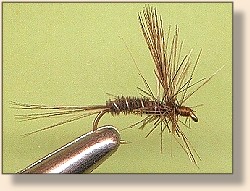Dry fly hackle usually comes from the neck and back of the
Indio rooster. It has a different shape and texture than
the feathers commonly used for tailing and other purposes
and comes in colors and shades to match most every hatch.
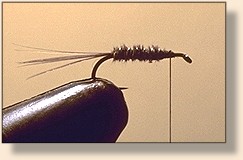
1. Tie in the tail and body of the fly you wish to
represent, leaving the thread in the position pictured.
The superior stiffness of Coq de Leon supports the fly
on the surface better than traditional hackle.
2. Prepare the hackle by grasping the tip between the
thumb and finger. Be sure to grasp just enough fibers so
the wing length will be between 1½ to 2 times the hook gap.
With the other hand, grasp the fibers below the wing and
slide them toward the base. The hackle fibers will flare
out perpendicular to the stem. Cut away a couple fibers
between the wing and flared hackle, on both sides, to allow
for the thread when tying to the hook shank. Trim the hackle
fibers, evenly on both sides, the same length, or slightly
shorter, than the wing is long.
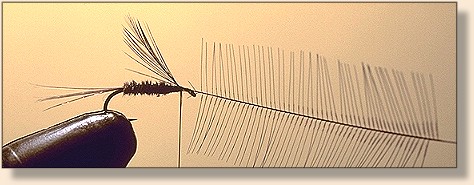
3. Tie in the wing tip by laying the hackle tip toward
the rear and in line with the hook. Wrap the thread snug
behind the wing 2 or 3 times to support the wing upright
and then forward to the head position. Note: If your wing
is different than the hackle then tie them in separate, but
always leave the base of the hackle in front of the wing.
You can lightly splay wings by tying the hackle stem through
the middle.
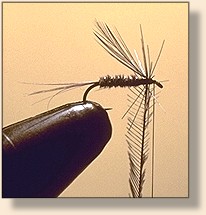
4. Wrap the hackle two times after it starts to flare,
once in front of the wing and once behind it. Note:
I sometimes wrap hackle twice in front and back but it
is not quite as realistic on the water.
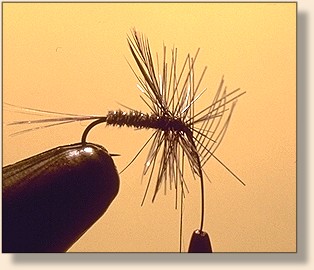
5. Then maneuver it forward, overlapping and oscillating
through the previous wraps, once behind and once forward
of the wing. The reason you overlap hackle is to make the
fibers stick out at angles to appear as legs along the
front of the body. This will not happen if you tie the
hackle the traditional way, or try to flare with thread.
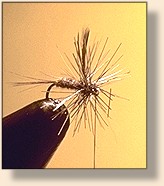
6. Tie off the hackle, clip, and whip finish. The hackle
should appear sparse and flared as pictured.
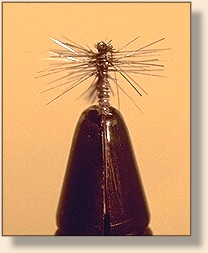
7. View the fly from the front and trim the underside hackle
to an inverted "V" shape (see picture).
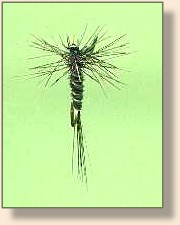
Note 1: You may find it easier to remove the fly
from the vice and hold it in your hand. The inverted "V"
causes the remaining hackle to rest in the surface film
as tiny little insect feet.
Note 2: I usually place a drop of penetrating head
cement or Zap-a-Gap on the underside of the hackle wrap to
give extra durability and extended life.
Now. . .go fish the "Ugly Fly" and you'll see for yourself
how realistic it appears on the water. Not only will it fool
the trout but it will fool you too, so keep an eye on it
because you'll confuse it with nearby naturals.
~ Ed Gallop
Tying Tip:
The Ugly fly is not only ugly but presents also advantages
and disadvantages.
Advantages:
It is very easy to tie.
Because of its single wing it won't twist your thin leader.
It will always make a kiss landing due to its aerodynamic
shape and won't hit the water.
Its footprint gives a realistic insect picture to trout.
Its high floatability gives a good visibility due to its
vertical wing and its separated hackle fibers equals the
parachute design thus avoiding the capilarity phenomenum.
The Indio hackle fiber properties act as water repellent
to avoid rapid sinking.
Disadvantages:
The great indio hackles are difficult to find, especially in
the right colors.(not for me :-))
It is very UGLY. ~ Paco
About Paco:
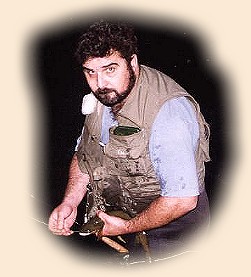 Paco is a veternarian specializing in breeding Coq de Leon.
He has a large variety of the best quality feathers available
anywhere in the world. He keeps his prices down by maintaining
a low overhead.
Paco is a veternarian specializing in breeding Coq de Leon.
He has a large variety of the best quality feathers available
anywhere in the world. He keeps his prices down by maintaining
a low overhead.
Paco's innovative creation of the "Ugly Fly" method of tying
mayfly duns and spinners has revolutionized my "match the hatch"
fly box. It's focus is on footprint and realism on the water's
surface and has proven to be very productive for me. He also
uses Coq de Leon for wings and tails on a variety of insect imitations.
His website is
https://coqdeleonfeathers.homestead.com/index.php
~ Ed Gallop
Publisher's Note: For more about Coq de Leon, including
photos of the bird itself and the various feathers, visit
www.angelfire.com/va2/dryflyer/.

